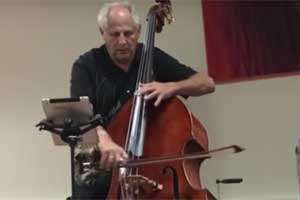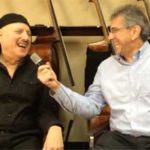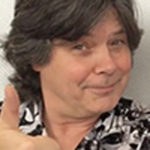Symphony player, composer and educator shares insights on orchestral playing, programs for young bassists and his mega-popular “Inner Game” series
Exclusive interview with FBPO’s Jon Liebman
February 22, 2010
Barry Green, a native Californian, served as principal bassist of the Cincinnati Symphony for 28 years and professor of bass at the University of Cincinnati College-Conservatory of Music. Green was also executive director of the International Society of Bassists from 1975 to 1981.
He is the author of the extremely popular The Inner Game of Music, as well as seven “Inner Game” workbooks and a video with W. Timothy Gallwey. Green recently authored a unique series of books, The Popular Bass Method (five volumes) with jazz bassist Jeff Neighbor.
Green’s solo recordings include The Baroque Bass, The Romantic Bass, Contemporary Music for the Double Bass, The Sound of the Bass, Bass Evolution and two recent CDs, Ole-Cool and Live From St. Croix, with Cincinnati pianist-arranger James Hart, percussionist-son Adam Green plus the Spanish Quartet de Barcelone.
In addition to serving as principal bassist with the California Symphony and the Sun Valley Summer Symphony, Green currently directs a Young Bassist Program for the San Francisco Symphony Education Department. He also teaches at the University of California-Santa Cruz and remains active as a soloist, educator and clinician in the Bay Area, as well as on tour.
FBPO: It appears you have made the bass your life’s work – performing, teaching, arranging… What prompted you to take up the instrument in the first place? Was it your first choice?
BG: My first instrument was accordion when I was 7 years old. A professional accordion player lived across the street and I loved hearing him practice! While in junior high school, I was recruited by the music teacher because I had seven years of musical experience, but didn’t play anything that was used in the school band or orchestra.
My parents said: “The accordion stays at home! If you want to play something at school, then choose something BIG like the bass or the tuba so it stays at school and doesn’t come into the house!!! Your room already has too much junk!” So I chose the tuba first and then went to the bass after a year so I could play in all the school groups.
It was ironic that I couldn’t play the accordion in the school groups, but later, after being the Principal Bassist of the Cincinnati Symphony, I also became the “official” accordionist of the CSO! So that’s me playing on our Pops recordings with Erich Kunzel, the Mancini albums, Western themes, movie themes, etc. My ultimate achievement was being flown in by the Cincinnati Symphony from Paris, France, to play the accordion solo on Victor Victoria at Carnegie Hall! Yes, that’s right! While serving as Principal Bassist with the orchestra, I was on leave of absence studying with François Rabbath and Kunzel insisted that I play the Carnegie Hall tour concert. So they flew me in as a “guest artist!” I made it to Carnegie Hall playing the accordion solo with the Cincinnati Symphony, but I wasn’t allowed to play my accordion in my junior high school band or orchestra! Our music education system missed the mark there!
FBPO: You spent so many years in Cincinnati. What made you decide to return to your native California?
BG: I loved my time playing in the CSO! Best seat in the house for all those amazing concerts. It also afforded me the opportunity to study the workings of the symphony and the conductors’ efficiency of their instructions, which was the basis for my writing The Inner Game of Music book and more. However, Frank Proto – fellow bassist, composer and dear friend – set the record for requesting “time off” for our pet projects, tours, workshops and musical passions outside of the symphony. I was a native Californian living in the Midwest. After 28 great years in Cincinnati, I discovered that I could do what I’m most passionate about without being a full-time member of an orchestra. I wouldn’t have to ask anyone’s permission to take time off to go to a convention, do a tour, study or write a book. Also, my parents are still kicking and living in Santa Rosa, only about an hour-and-a-half from where I live now. My brother and cousins live in the Bay Area, too. It was time to go back to California, where everything had begun for me. While I never worked in the Bay Area before, I did go to San Jose State for a year-and-a-half before transferring to Indiana University for my music education. In California, I was never lacking for work. I also made a point of doing original work in California, so I wouldn’t take anyone else’s job. That’s why I started teaching young bassists from scratch. I’ve now been here for 15 years.
FBPO: You seem to have a real passion for teaching. Tell me about The Popular Bass Method series.
BG: This book is my third book on bass technique. My first two books, Fundamentals of Double Bass Playing and Advanced Techniques of Double Bass Playing (for college level) and finally this book, all helped me with my new students here in California. My newest book follows the sequence of positions of George Vance’s Progressive Bass Studies, which is also based on the Rabbath system. It provides duets and tunes that are more age appropriate for high school-aged students and adults, using classical, folk, jazz, rock, funk and blues tunes and it progresses sequentially. The kids love playing the music! I can’t motivate a student when they don’t like the tunes they are playing. I’ve had difficulty keeping the book in print and currently I’m between printings because it is expensive to sit on inventory. It’s currently being handled by Lemur.
FBPO: Your “Inner Game” series has been phenomenally successful, having sold over 250,000 copies. What is the “inner game” approach? And, if I’m not mistaken, wasn’t there some connection to the game of tennis?
BG: Yes. The Inner Game of Music is based on The Inner Game of Tennis. I wrote that book under the mentorship of Timothy Gallwey, the author. Technically, the book is written by me along with Gallwey. I have also done seven workbooks for individuals and ensembles in this series and a video, as well. I have a website devoted to these topics. The concept is simple and based on three skills of concentration: awareness, commitment, and trust.
The goal is to focus on the music and not your doubts and fears. With proper focus, you connect with the good stuff. It’s that simple. The principles are based on the Eastern philosophy that has been around for thousands of years and it still works. Since The Inner Game of Music, I have written two more books: The Mastery of Music and 10 pathways to True Artistry, which is based on qualities of the human spirit, like passion, courage, confidence, tolerance, creativity, humor, communication, etc. “Pathways” is very inspirational and based on the human spirit. I developed it based on over 120 interviews with great musicians like Bobby McFerrin, Joshua Bell, Dave Brubeck and Frederica VonStade. Both these books are published by Broadway/Doubleday and easily available in bookstores and online merchants like amazon.com.
My most recent book was published last September by GIA MUSIC. It’s called Bringing Music to Life andit covers the same approach as The Inner Game of Music, but it’s for the body! It deals with channeling music through the performing artist/actors, dancers and musicians. It is also based on the mastery of just three body skills: breath, pulse, and movement. We are currently preparing a DVD that may be released by GIA this spring. It’s designed for the individual as well as groups, teachers and high schools. I’m most excited about what I am doing now and this is my current passion.
FBPO: You’ve also been pretty prolific in your CD releases. Can you touch on a few highlights?
BG: I did five solo albums on vinyl, none of which has been converted to CD. Frankly, I’m a bit embarrassed to re-issue them, as I really don’t play like that any more. They’re old – I guess so am I! – but I like to think I’ve aged like a bottle of wine, having gotten better over time! Over the last fifteen years, I’ve recorded two CDs and, most recently, I’ve put several live concert selections on YouTube under my name or a weird spelling of “doublebbassist.” These recent recordings best represent my current playing.
How about Ole-Cool, your latest release?
Ole-Cool was recorded when I came to California 15 years ago. It represents my collaborations in Spain and America with two groups of colleagues. My American stuff was based on arrangements of my pianist James Hart, with swinging baroque sonatas by Bach and Vivaldi. The Spanish side was a similar fusion of Spanish music in a contemporary flamenco style.
A few years ago, I recorded Live from St.Croix, which is closer to the playing style I embrace now. That concert was also with Jim Hart, my Cincinnati pianist. We played music of Proto, Tony Osborne and more, all with bass and piano and all live. I also did a jazz CD called Seat of the Pants, with music by Lenny Carlson.
FBPO: What was it like to study with François Rabbath?
BG: Well, I first brought Rabbath to the U.S when we did our Bass Schools in Cincinnati program in 1978, so I have known and used his materials with my students for many years. I ran his institute in Cincinnati and brought him to California several times in the ’90s, as well.
I didn’t really study with François for my own bass playing until 1990 and I’m not even sure about that date. I was playing Jon Deak’s Jack and the Beanstalk as soloist with the CSO and we worked on that. In 1988 I heard François play Reitba at the UCLA ISB (International Society of Bassists) convention and that was the final straw for me that inspired me to make time to go study with him. I wanted to learn how to pay Reitba too! Well, François helped me with Jon Deak’s challenging music, but he wouldn’t teach me Reitba, actually, ever. I tell this story in the “Passion” chapter of my book, The Mastery of Music. My experience with François was a long, personal journey of letting go of the past and absorbing the new, without a specific timetable.
François treated me like a son. I would spend weeks with him, staying in his home, so lessons went beyond the bass. It is still amazing to hear him in concert. He sounds as good in his late 70s as he did in his 50s – super human! No one can do what he does. I had to take that experience of his advanced technique and allow it to integrate with my own expression. Frankly, I think it has taken me perhaps twenty years to find my own voice with my bass, which was inspired by my work with François. I was initially moved by his presence, his personality and his ability to reach an audience through his bass. This is what I aspire to do now in concerts – make a connection with the people, express and bear my soul and communicate through my body and music. It just happens that I’ll hold a bass in my hands while I do that. My hope is to have the bass disappear so I can just share the joy of the inspiration I feel with others in the room. That’s my goal and this was what inspired me with François.
FBPO: What’s the Northern California Bass Club?
BG: I have always been an “organization” person, as was the case when I was leading the ISB back in the ’70s and ’80s. So when I came back to California, it was natural for me to organize a bass club with colleagues. We started “Bass Bashes” and got together two or three times a year. Now we are up to perhaps “Bass 30-something.” We have had just about everybody in the bass business, including jazz, classical and electric bass legends, because many of the players have been colleagues and friends over the years. They have included Gary Karr, François Rabbath, Edgar Meyer, Ray Brown, John Clayton, John Patitucci, Michael Manring and others.
We also have an educational Bass Bash each spring that allows the students in my San Francisco Symphony Young Bassist Program to perform in ensembles. We offer a guest recital and master class for them. This spring we will have Eric Hansen from BYU be our guest and we will have over a hundred bassists perform in small and large ensembles.
We also have a Summer Bass Camp, called the Golden Gate Bass Camp, which is huge. It is one week in July and includes about sixteen great teachers, a staff of eight and about sixty high school and middle school campers plus adult courses. You can access the bass camp through our sight www.goldengatebasscamp.com . This year’s camp is July 19th-25th and takes place in Oakland, California, at Holy Names University. In 2011, we are planning on hosting the ISB International Convention! This is a collaborative project through our Bass Club and San Francisco State University. The official announcement is in the process of being made by the ISB but I’m proud to announce it right here on FBPO first!
FBPO: I admire your energy and your genuine passion for the bass. You must be working on something – or several somethings! – now. What can we expect from you next?
BG: I’m working on a DVD that will be a companion to Bringing Music to Life that literally brings these concepts to life. It’s scheduled to be out in the spring. Beyond the DVD, the new website will continue this work. It involves blogs, webcasts, perhaps clinics, interviews, live events, education courses, integrating all the technology that exists today. My goal is to have this site dedicated to everything other than technique, all those things performing artists share having to do with communication and artistry: dancers, actors, musicians etc. The site is in the development stage but it will grow with your participation! Go to www.thegreenartsnetwork.com.
I hope to continue doing a lot of bass playing. I love to play the bass! My latest concert project had to do with listening to music through your body, so I showed YouTube clips of dances and got the audience to stand up and dance to the styles of the music I was about to play. Then I had them sit and move tastefully while I played music based on folk cultures – samba, hora, river dance, tango, etc. I loved this concept and hope to do more of it. I’m still a bass player first.
FBPO: What do you like to do that doesn’t involve music?
BG: NIA, which is a path to condition, heal and express yourself through movement and sensation. It’s a dynamic blend of dance arts, martial arts and healing arts, which revolutionized the face of fitness in 1983. Balancing technical precision with free-form expression, NIA brings the body, mind, emotions and spirit to optimum health through music, movement and self-expression, guided by the sensation of pleasure.
I also love my wife, my children and three grandchildren, nature, living in California, good wine, hiking, jogging, the gym, my Cincinnati Bengals and Reds (I know they sometimes stink!). Most of the time I love traveling and meeting people in different cultures and countries.







